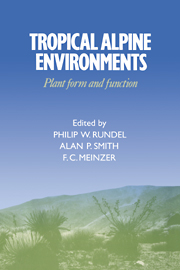Book contents
- Frontmatter
- Contents
- List of contributors
- Preface
- 1 Introduction to tropical alpine vegetation
- 2 Tropical alpine climates
- 3 Páramo microclimate and leaf thermal balance of Andean giant rosette plants
- 4 Comparative water relations of tropical alpine plants
- 5 Cold tolerance in tropical alpine plants
- 6 Anatomy of tropical alpine plants
- 7 Environmental biology of a tropical treeline species, Polylepis sericea
- 8 Morphological and physiological radiation in páramo Draba
- 9 Sediment-based carbon nutrition in tropical alpine Isoetes
- 10 Functional significance of inflorescence pubescence in tropical alpine species of Puya
- 11 Turnover and conservation of nutrients in the pachycaul Senecio keniodendron
- 12 Soil nutrient dynamics in East African alpine ecosystems
- 13 An overview of the reproductive biology of Espeletia (Asteraceae) in the Venezuelan Andes
- 14 Population biology of Mount Kenya lobelias
- 15 Population biology of Senecio keniodendron (Asteraceae), an Afroalpine giant rosette plant
- 16 Population dynamics and flowering in a Hawaiian alpine rosette plant, Argyroxiphium sandwicense
- 17 Plant form and function in alpine New Guinea
- 18 Alpine herbivory on Mount Kenya
- 19 Biotic interactions in Hawaiian high elevation ecosystems
- 20 Tropical alpine ecology: progress and priorities
- Index
19 - Biotic interactions in Hawaiian high elevation ecosystems
Published online by Cambridge University Press: 21 October 2009
- Frontmatter
- Contents
- List of contributors
- Preface
- 1 Introduction to tropical alpine vegetation
- 2 Tropical alpine climates
- 3 Páramo microclimate and leaf thermal balance of Andean giant rosette plants
- 4 Comparative water relations of tropical alpine plants
- 5 Cold tolerance in tropical alpine plants
- 6 Anatomy of tropical alpine plants
- 7 Environmental biology of a tropical treeline species, Polylepis sericea
- 8 Morphological and physiological radiation in páramo Draba
- 9 Sediment-based carbon nutrition in tropical alpine Isoetes
- 10 Functional significance of inflorescence pubescence in tropical alpine species of Puya
- 11 Turnover and conservation of nutrients in the pachycaul Senecio keniodendron
- 12 Soil nutrient dynamics in East African alpine ecosystems
- 13 An overview of the reproductive biology of Espeletia (Asteraceae) in the Venezuelan Andes
- 14 Population biology of Mount Kenya lobelias
- 15 Population biology of Senecio keniodendron (Asteraceae), an Afroalpine giant rosette plant
- 16 Population dynamics and flowering in a Hawaiian alpine rosette plant, Argyroxiphium sandwicense
- 17 Plant form and function in alpine New Guinea
- 18 Alpine herbivory on Mount Kenya
- 19 Biotic interactions in Hawaiian high elevation ecosystems
- 20 Tropical alpine ecology: progress and priorities
- Index
Summary
Introduction
High elevation shrublands occur above the tradewind inversion (c. 2000 m), on the geologically young (< 1 000 000 years old) volcanoes of Maui (Haleakala volcano) and Hawaiian (Mauna Kea, Mauna Loa and Hualalai volcanoes). Except for Mauna Loa, which recently erupted at the 3000 m level in 1984, these volcanoes are quiescent. Vegetation of the high elevation Hawaiian volcanoes consists of shrubs (Styphelia, Coprosma, Vaccinium, Dubautia, Dodonaea, Geranium), small trees (Sophora, Myoporum, Santalum), perennial graminoids (Deschampsia, Agrostis, Trisetum, Luzula, Carex), and other perennial herbaceous species (Pteridium aquilinum, Asplenium, Silene, Sanicula, etc.). With increasingly severe climatic conditions at higher elevations and with proximity to a mountain's summit, vegetation becomes more sparse and smaller in stature. Vegetation at the uppermost limit consists of prostrate shrubs, grasses, and ferns (Hartt & Neal 1940; Fosberg 1959; Mueller-Dombois & Krajina 1968; Whiteaker 1983). The fresh lava substrates of Mauna Loa (elevation 4170 m) result in much less development of soil and vegetation there than on older Mauna Kea (4207 m) and Haleakala (3056 m), both of which have extensive outcrops of cinder and ash deposits (Fosberg 1959). Hualalai Volcano (2522 m) barely reaches into the high elevation zone.
Mean temperature in the Hawaiian Islands decreases upward on the volcanoes at a rate of about 0.53 °C per 100 m.
- Type
- Chapter
- Information
- Tropical Alpine EnvironmentsPlant Form and Function, pp. 337 - 354Publisher: Cambridge University PressPrint publication year: 1994
- 4
- Cited by

